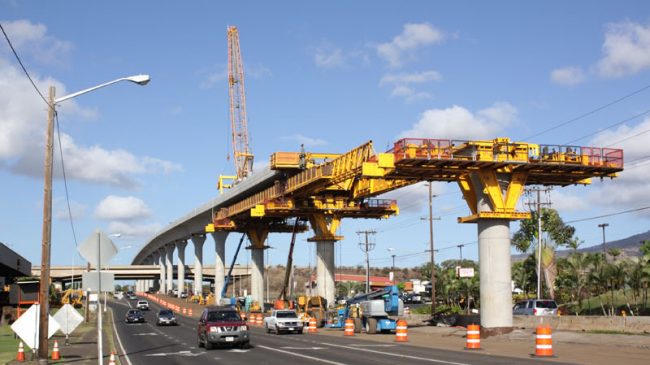On November 23rd, CBS’s “60 Minutes” aired a segment called “Falling Apart: America’s Neglected Infrastructure.” Its centerpiece was structurally deficient bridges in Pittsburgh, one of which has a structure build underneath it to prevent falling concrete from hitting vehicles on the highway below. Former Transportation Secretary Ray LaHood and former Pennsylvania Governor Ed Rendell intoned the usual solution: much higher fuel taxes.
Pennsylvania is a poster child for both structurally deficient and functionally obsolete bridges, but it’s one of a small group of states (including Connecticut, Hawaii, Massachusetts, and New York) with serious bridge problems. In most states, with lower overall percentages, the majority of their problems are functional obsolescence. But in Pennsylvania, structurally deficient bridges outnumber ones with insufficient lanes.
A less sensational look at the impact of bridge problems was recently released by the Oregon Department of Transportation (ODOT). “Rough Roads Ahead” reports that with current funding, it will be impossible to maintain the mostly good conditions of that state’s roads and bridges, and presents the findings of an economic analysis estimating the impact on goods movement (and hence to Oregon’s economy) if ODOT has to implement highway and bridge funding triage over the next two decades. It’s not a pretty picture.
What I find troubling about these and other reports lamenting the troubled state of U.S. infrastructure is the lack of discussion about perverse incentives built into the way we do highways in this country. Both elected officials and contractors (in the traditional design-bid-build world) face incentives that lead to getting far less bang for the buck out of surface transportation budgets.
Legislators want to have as many ribbon-cutting projects as possible that they can claim credit for, so they press their Department of Transportation (DOT) to make the construction budget go as far as possible. That leads to barely adequate pavement standards that lead to much greater need for maintenance over a highway’s useful life. They exacerbate this problem by allocating a larger fraction of the transportation budget to construction (new or replacement) than to maintenance.
Contractors in the design-bid-build (DBB) world have every incentive to play along with this system. They can bid low to get the job and usually justify costly change orders during construction. And unless there are serious daily cost penalties for late completion, they have few incentives to make sure projects get completed on time. An extreme example was the notorious Big Dig project in Boston, but mega-projects in general are well-known for large-scale cost overruns and late completion.
If we really want to get the most real output of transportation infrastructure from however much money is available, these perverse incentives must be confronted and changed. In this regard, the growing use of public private partnership (P3) concessions offers a real paradigm shift. In a design-build-finance-operate-maintain concession, the concession company has very different incentives from a DBB construction contractor. Since the concessionaire will be the de-facto owner of the project for the long term of the agreement, it has a powerful incentive to minimize not the initial construction cost but the life-cycle cost of the project. Furthermore, under either a toll concession or an availability-pay (AP) concession, proper ongoing maintenance is a requirement of the agreement, besides being something the concessionaire has a strong incentive to do, so as not to lose customers to alternative routes. The concessionaire also faces strong incentives to get the project finished on time and open to traffic, so as to get the revenue stream flowing to start paying the debt service it has taken on.
Reinforcing these incentives is dedicated funding. In an AP concession, that revenue stream is contractually guaranteed, subject of course to appropriation risk in future years. With a toll concession, the revenue stream depends on both the value proposition being offered to customers and the soundness of the traffic and revenue projection on which the project was financed.
To illustrate the difference this paradigm shift can make, consider this country’s number one unfunded infrastructure need: reconstructing and modernizing the entire Interstate highway system–a $1-to-2 trillion project (depending on whose numbers you believe) that is currently not funded. The conventional wisdom (of “60 Minutes” and various advocacy groups) is to enact a large increase in the federal gasoline and diesel taxes. But even if the huge political opposition to doing this could be overcome, the proceeds would almost certainly be used to bail out the Highway Trust Fund. And in that scenario, every single interest group would lobby hard (probably successfully) for its proportionate share of the increase-for transit, bike lanes, sidewalks, recreational trails, highway safety grants, etc.
By contrast, consider a scenario in which states get the option to self-fund the reconstruction of their Interstates using dedicated revenues from all-electronic tolling. Every dollar thus collected can and should be used to finance that massive reconstruction and widening program, including all the bridges on that system that need replacement or refurbishment. And if the state in question wants to do the program right, it would use the P3 concession model to ensure that the replacement facilities are built durably so as to minimize life-cycle costs, and with strong incentives (and funding) in place to guarantee proper ongoing maintenance. Under these circumstances, the second-generation Interstate system would be better-designed, better-built, and better-maintained than its aging predecessor.
Moreover, an important bonus for any state choosing this way forward would be that by self-funding its Interstate reconstruction and maintenance program, it would free up its existing federal and state highway money to tackle its many non-Interstate bridges and highways that need repair, expansion, or replacement.
Yes, we do need more investment in America’s highway system. But simply pumping more dollars into a flawed system will not generate the greatest bang for the buck. Only a system that changes the perverse incentives of America’s traditional system for highway building will do that.
Robert Poole is director of transportation at Reason Foundation. This column first appeared in Public Works Financing.

